Introduction
Law firms today grapple with high client expectations, immense documentation loads, and pressure to deliver swift, accurate outcomes. Artificial Intelligence (AI) is stepping in, not to replace legal expertise, but to automate routine workflows, enhance research, boost efficiency, and elevate strategic legal advisory.
This comprehensive guide dives into how AI is transforming law firms across practice areas, and what leaders must know to harness its power responsibly.
What is AI and Why Does It Matter in Law Firms?
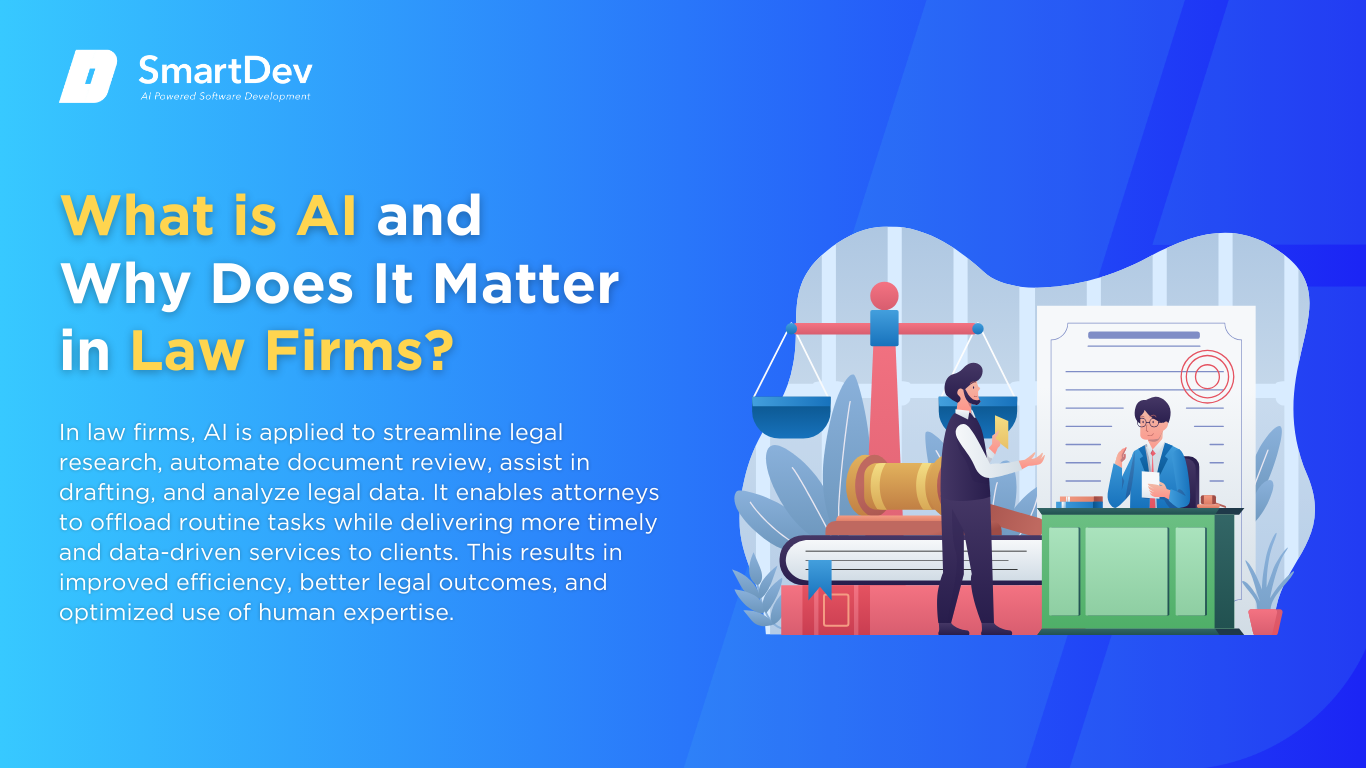
Definition of AI and Its Core Technologies
AI refers to computer systems that can perform tasks typically requiring human intelligence, such as learning, reasoning, and decision-making. These systems are powered by technologies like machine learning, natural language processing (NLP), and predictive analytics. AI is increasingly used across industries to automate processes and enhance decision-making.
In law firms, AI is applied to streamline legal research, automate document review, assist in drafting, and analyze legal data. It enables attorneys to offload routine tasks while delivering more timely and data-driven services to clients. This results in improved efficiency, better legal outcomes, and optimized use of human expertise.
The Growing Role of AI in Transforming Law Firms
AI is revolutionizing core functions in legal practice, from contract analysis to litigation support. Leading firms are integrating generative AI and machine learning tools to scan case law, statutes, and filings, dramatically reducing research time and increasing the relevance of findings. This allows legal teams to move faster while maintaining a high standard of accuracy.
AI also drives more consistent and precise document handling. Tools like legal-specific LLMs assist in drafting, formatting, and summarizing documents, enabling firms to deliver work at scale. By automating low-value tasks, attorneys can focus more on complex analysis, negotiation, and strategy.
Operationally, AI is transforming law firm workflows. Invoice review, compliance checks, and due diligence are increasingly managed by AI-driven platforms, significantly reducing costs and turnaround time. With built-in audit trails and real-time feedback, firms enhance both client transparency and internal accountability.
Key Statistics and Trends in AI Adoption in Life Insurance
AI adoption within the legal profession has experienced significant growth, with 30% of attorneys utilizing AI tools in 2024, up from 11% in 2023. Larger firms, particularly those with 100 or more attorneys, lead this trend, with 46% reporting the use of AI-based technologies. Conversely, solo practitioners and smaller firms have lower adoption rates, at 18% and 30% respectively.
The use of generative AI tools among legal professionals has nearly doubled, rising from 14% in 2024 to 26% in 2025. Among law firms, 33% of users engage with these tools multiple times weekly, highlighting their growing integration into daily workflows. Notably, 59% of law firm professionals believe generative AI should be applied to their work, reflecting a shift towards embracing AI for enhancing productivity and efficiency.
The integration of AI in legal practices is yielding substantial benefits, including time savings and increased efficiency. AI tools have the potential to save legal professionals up to 240 hours annually, translating to an average annual value of $19,000 per professional. Furthermore, 59% of corporate legal department respondents expect their law firms to utilize generative AI, indicating that clients are increasingly anticipating AI-driven services from their legal providers.
Business Benefits of AI in Law Firms
AI addresses long-standing inefficiencies in law firms, such as time-consuming research, high operational costs, and limited capacity for scaling personalized services. Below are five essential business benefits that AI delivers to legal practices aiming to boost performance and client satisfaction:
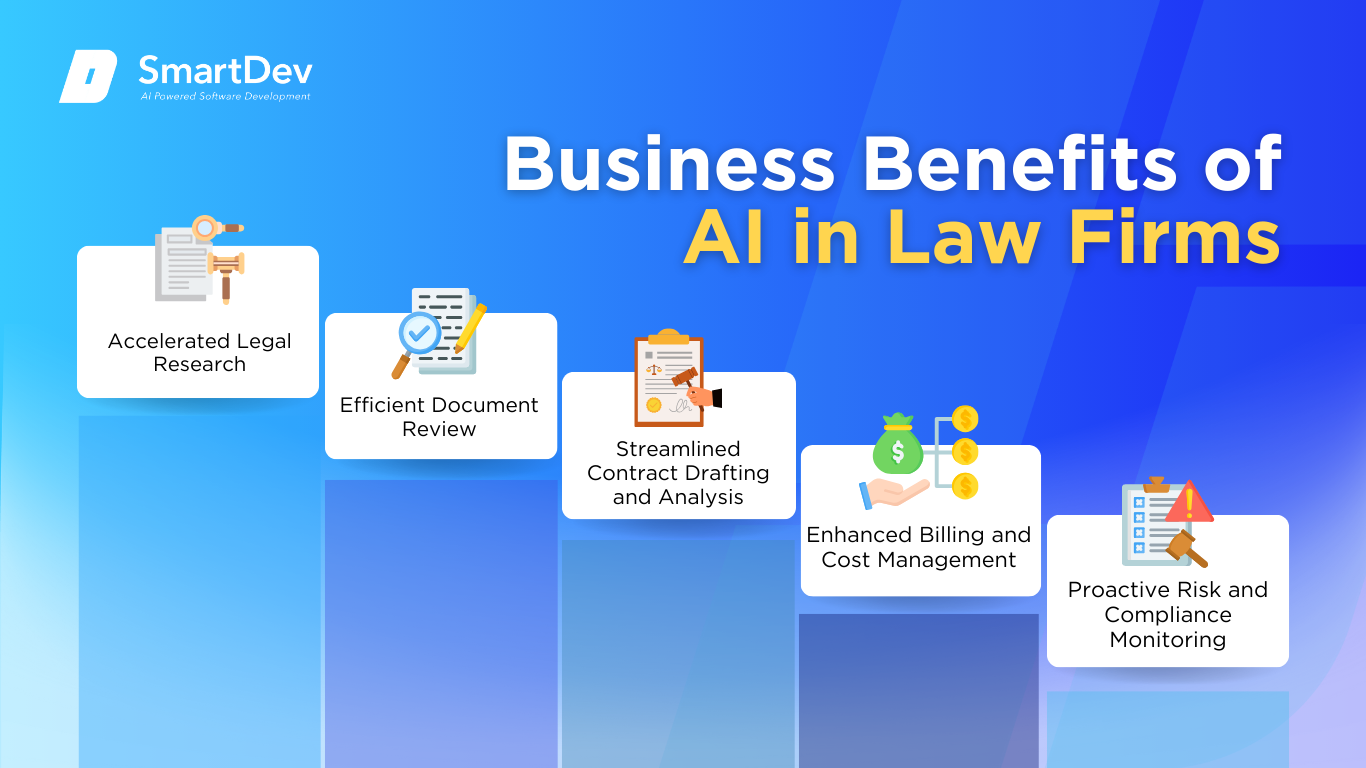
1. Accelerated Legal Research
AI dramatically reduces the time attorneys spend searching through case law, statutes, and legal commentary. Advanced tools return precise, relevant results in seconds—allowing legal teams to move quickly without sacrificing accuracy. This speed is critical when handling urgent or high-stakes matters where every minute counts.
Moreover, AI-supported legal research goes beyond keyword matching. Many platforms now use semantic search, enabling users to uncover relevant cases even if exact terms don’t match. This minimizes blind spots and helps uncover novel arguments that can make or break a case. With citation tracking and contextual summaries, legal teams can gain deeper insights, faster.
2. Efficient Document Review
Document review, particularly in eDiscovery and compliance audits, is one of the most time- and cost-intensive parts of legal work. AI tools can now process and categorize thousands of documents in hours, work that previously took teams of paralegals days or weeks to complete. By identifying privileged or relevant materials early, these tools help streamline discovery phases and avoid costly delays.
In addition, AI-powered platforms improve accuracy over time by learning from attorney feedback. The more the system is used, the more precise it becomes in identifying document types, themes, and risk indicators. This consistency improves legal defensibility and client confidence in the review process.
3. Streamlined Contract Drafting and Analysis
Contract lifecycle management is another area where AI is transforming practice. From first draft to final signature, AI speeds up the drafting process through smart templates, clause libraries, and auto-suggestions based on previous agreements. This is especially valuable in high-volume contract environments such as M&A, real estate, or vendor agreements.
On the analysis side, AI tools flag missing clauses, non-standard language, or risky terms, reducing the time attorneys spend manually reviewing line by line. They also help compare versions and track changes, supporting more agile negotiations. Ultimately, this means contracts are not only produced faster but also with higher precision and lower risk exposure.
4. Enhanced Billing and Cost Management
AI in billing systems is helping law firms get paid faster, bill more accurately, and control costs. For example, AI can flag inconsistencies between time entries and billing guidelines before invoices are sent, reducing disputes and write-downs. Automated categorization of tasks ensures transparency and compliance with client expectations.
Advanced analytics also allow firms to forecast revenue, track utilization, and identify areas of overspending or inefficiency. When paired with predictive modeling, firms can make smarter resourcing decisions, price more competitively, and ensure long-term profitability.
5. Proactive Risk and Compliance Monitoring
Law firms are under increasing pressure to anticipate legal risks before they escalate. AI tools continuously monitor internal and external data sources, such as regulatory updates, court rulings, and client disclosures, to identify areas of concern. This proactive approach allows firms to offer early warnings and preventative counsel.
In due diligence and onboarding, AI enhances the depth and speed of reviews. By analyzing corporate filings, sanctions lists, and litigation histories, firms can surface red flags faster and ensure compliance with Know Your Client (KYC) obligations. These insights protect both firm reputation and client interests.
Challenges Facing AI Adoption in Law Firms
While AI offers significant advantages, implementing it within legal ecosystems presents a range of practical and strategic obstacles. Below are five critical challenges law firms must address to adopt AI effectively:
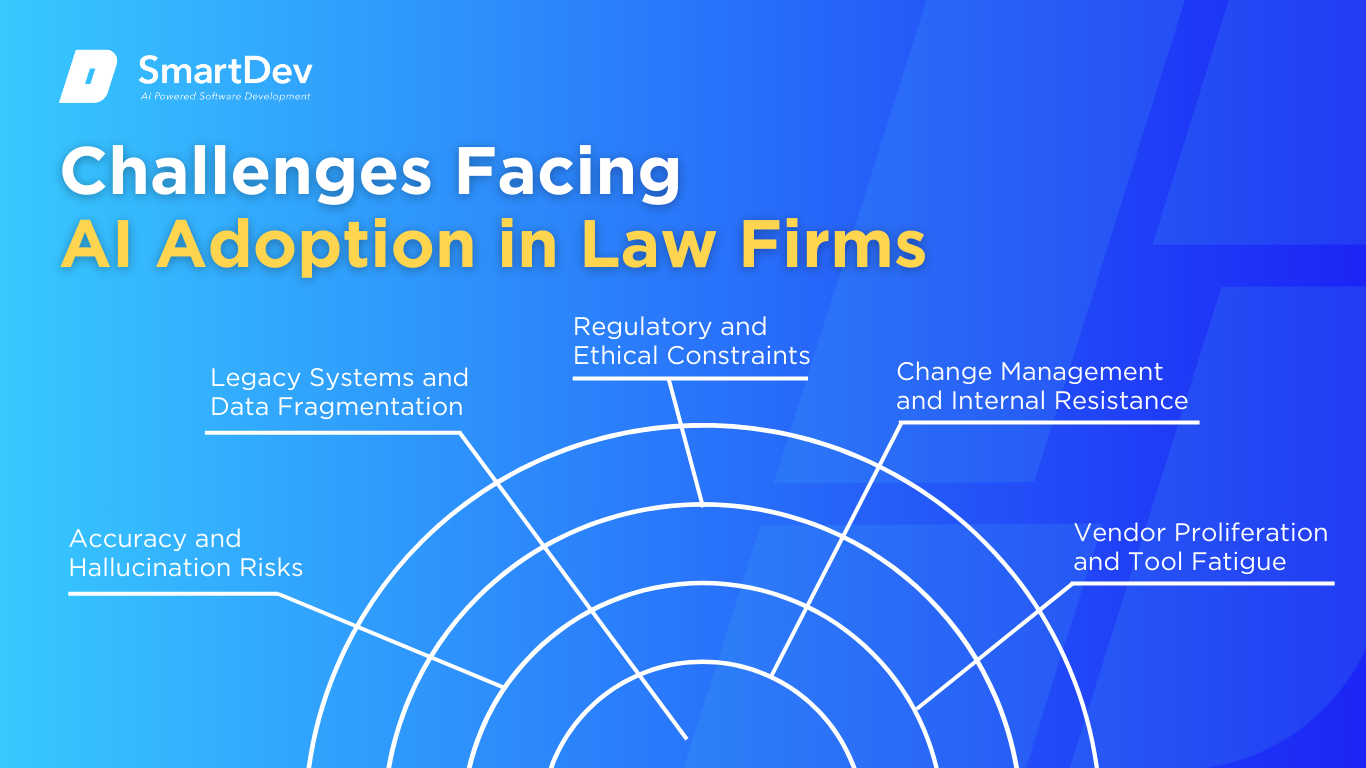
1. Legacy Systems and Data Fragmentation
Many law firms operate on outdated or siloed technology stacks, which limit the accessibility and reliability of the data required to train or feed AI systems. Inconsistent data formats across case management, billing, and document systems create barriers to integration and automation. Without standardized and high-quality inputs, AI outputs often fail to deliver meaningful value.
Modernizing this infrastructure requires not only budget and technical planning, but also collaboration between IT, legal operations, and leadership. Firms that do not address foundational data challenges may find AI tools underperforming or yielding untrustworthy results, undermining broader digital transformation goals.
2. Accuracy and Hallucination Risks
Generative AI systems are prone to hallucination, producing plausible but incorrect or fabricated outputs. In the legal domain, where precision is paramount, this can result in false citations, misinterpreted precedents, or invalid legal arguments. Such errors can severely damage client outcomes and a firm’s credibility.
To mitigate this, firms must implement robust human-in-the-loop review processes and establish protocols for verifying AI-generated content. Without clear accountability and validation, legal professionals risk breaching ethical duties and exposing themselves to malpractice claims.
3. Regulatory and Ethical Constraints
Legal practice is tightly governed by professional responsibility rules, confidentiality obligations, and jurisdiction-specific laws. The use of AI must align with these standards, particularly regarding client data privacy and the duty of technological competence. Failure to comply could lead to disciplinary actions or reputational harm.
Many jurisdictions now require lawyers to stay informed about technology’s impact on their practice. As AI tools evolve, so must firm policies, compliance reviews, and attorney training to ensure alignment with evolving legal ethics.
4. Change Management and Internal Resistance
Introducing AI requires significant cultural change, particularly in firms with deeply entrenched traditions and hierarchical structures. Attorneys may be skeptical of AI’s accuracy or fear it could replace human judgment, reducing their perceived value or job security. Operational staff may resist learning new systems or altering workflows.
Successful adoption hinges on thoughtful change management, demonstrating how AI augments rather than replaces legal expertise. Pilot programs, peer training, and transparent communication about benefits and limitations can foster engagement and trust.
5. Vendor Proliferation and Tool Fatigue
The legal tech market has exploded with AI-powered tools, each promising unique features or efficiencies. However, the abundance of options can overwhelm decision-makers, leading to fragmented tech stacks or unused subscriptions. Without a cohesive strategy, firms may overinvest in overlapping solutions or fail to scale successful pilots.
To overcome this, law firms need clear procurement criteria, internal champions, and integration roadmaps. Aligning AI tools with specific business needs and workflows ensures adoption drives measurable value rather than technology fatigue.
Specific Applications of AI in Law Firms
From document review automation to predictive analytics, AI is redefining how law firms operate, analyze legal information, and deliver client services. These technologies are enabling faster research, more accurate drafting, and data‑driven decisions, all while reducing operational costs and boosting productivity.
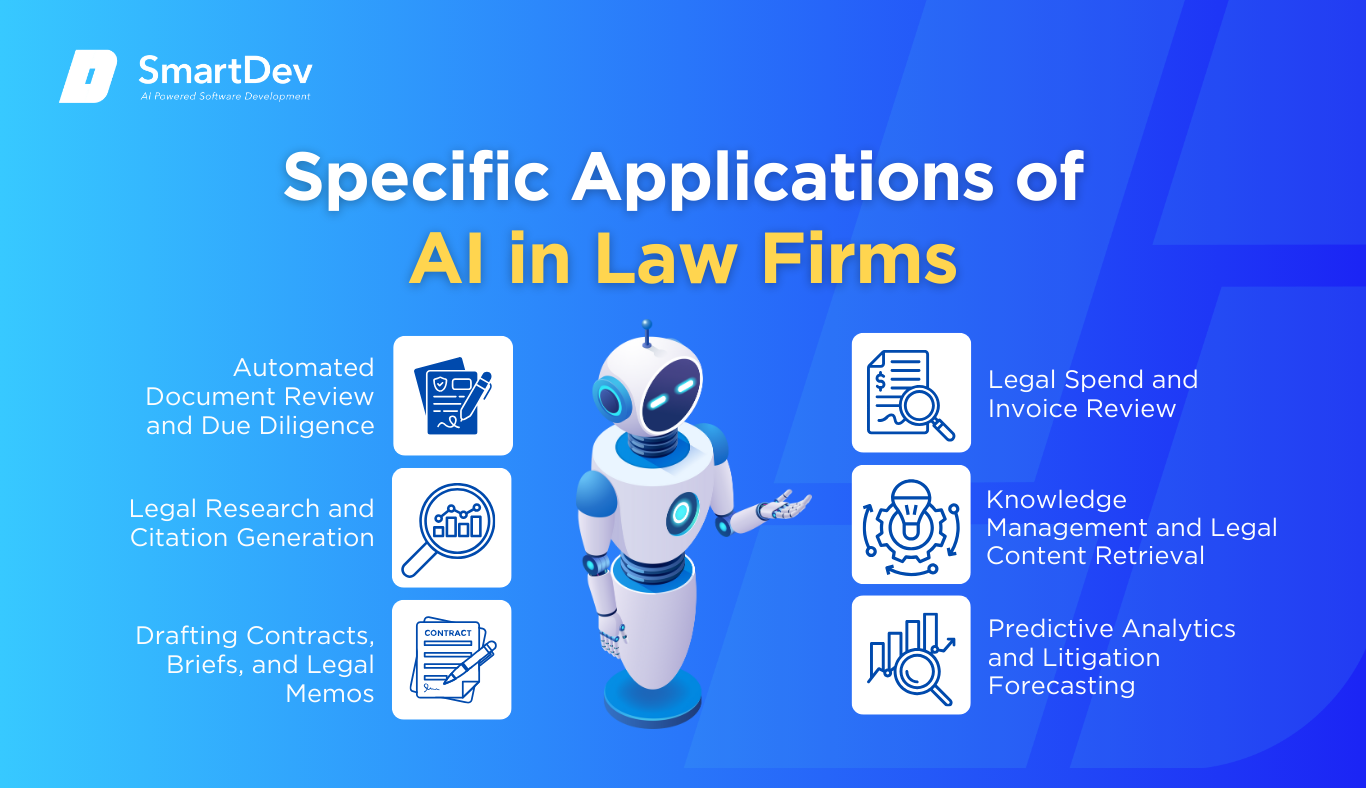
1. Automated Document Review and Due Diligence
AI-powered document review is transforming how law firms handle discovery, compliance checks, and contract analysis. Traditional document review requires attorneys and paralegals to manually sift through large volumes of contracts, emails, or filings, a time-consuming and error-prone task. AI addresses this bottleneck by leveraging natural language processing (NLP) and machine learning to identify relevant content, extract key clauses, and flag anomalies at scale.
These systems analyze thousands of documents using pretrained language models, classifying and tagging information like indemnity terms, obligations, or jurisdictional clauses. Algorithms trained on legal corpora highlight potential risks or missing elements and prioritize documents for human review. When integrated with legal management platforms like Relativity or Reveal, these AI tools streamline litigation workflows, improve compliance, and reduce review time from days to hours—while maintaining consistency and accuracy.
One strong example comes from Ashurst, a global law firm that uses Harvey AI and Microsoft Copilot for reviewing high-volume contracts during mergers and acquisitions. These tools extract deal-critical data from NDAs and vendor agreements, allowing lawyers to quickly assess legal exposure. By automating first-pass reviews, Ashurst reports reduced legal processing time and increased document accuracy during complex transactions.
2. Legal Research and Citation Generation
AI is revolutionizing legal research by enabling faster access to relevant case law, statutes, and legal opinions. Traditional legal research requires navigating vast databases and manually verifying case precedence, a slow and labor-intensive process. AI tools streamline this by using natural language queries and machine learning to surface the most relevant results, dramatically reducing time spent on research.
These systems use techniques like retrieval-augmented generation (RAG) and vector embeddings to scan large legal databases, retrieve relevant documents, and even generate citations or summaries. Some platforms combine proprietary case law libraries with generative AI models trained specifically on legal text, offering attorneys a direct path from question to legally grounded answers. When embedded within legal knowledge tools or firm intranets, these AI engines deliver more accurate, context-aware results with far less effort.
Ropes & Gray has adopted Harvey AI to assist with legal research and citation tasks. The platform enables associates to input complex legal questions and receive case-based responses complete with references and explanations. This has accelerated memo preparation timelines and improved accuracy in identifying relevant precedent, allowing attorneys to focus on higher-level legal analysis.
3. Drafting Contracts, Briefs, and Legal Memos
AI is playing an increasingly critical role in drafting legal content, from client emails and demand letters to court briefs and contracts. Traditionally, legal drafting requires extensive time, formatting precision, and legal reasoning, demanding both research and writing skills. AI-assisted drafting tools now generate legally structured content from prompts, templates, or past examples, allowing attorneys to start with high-quality first drafts.
These platforms are trained on large datasets of contracts, pleadings, and legal memos to learn tone, structure, and clause logic. Using large language models (LLMs), AI suggests full paragraphs, generates variations of standard clauses, and ensures formatting consistency based on jurisdiction or firm style guides. Integrated into word processors or case management systems, these tools reduce drafting time, improve consistency, and enhance productivity—while maintaining the attorney’s role in reviewing final content.
One strong example comes from Thomson Reuters, whose legal AI solutions report that 59% of professionals now use AI for brief or memo drafting. Their platform combines structured legal databases with generative AI, enabling efficient production of client communications and legal arguments. This has helped firms reduce writing time and scale legal services while maintaining quality and precision.
4. Legal Spend and Invoice Review
AI is streamlining how law firms and legal departments review legal bills, detect billing errors, and enforce outside counsel guidelines. Traditionally, invoice review is handled manually, requiring reviewers to read line-item descriptions and match them to approved activities, often resulting in missed errors and inconsistent enforcement. AI invoice reviewers automate this process with higher accuracy and speed.
These tools use classification models trained on legal billing codes, engagement letters, and historical invoices to spot non-compliant entries or duplicate charges. Some platforms pair LLMs with OCR and NLP tools to read scanned invoices and analyze unstructured billing narratives. Once integrated into legal operations systems, AI invoice review reduces processing time, flags issues in real time, and helps legal departments enforce spend policies more rigorously.
A 2024 academic study showing that LLMs outperformed humans in invoice review, achieving 92% accuracy versus 72% and completing reviews in less than 4 seconds per invoice. Tools like these are being integrated into enterprise legal spend platforms, driving significant time savings and improved spend compliance across legal departments.
5. Knowledge Management and Legal Content Retrieval
AI is enhancing how law firms manage internal knowledge, from previous case files to firm-generated templates and legal research. Historically, finding relevant internal content required manually browsing folders or relying on knowledge managers, a process often limited by poor tagging or forgotten files. AI-driven knowledge systems now index, classify, and surface relevant internal content automatically, improving reuse and institutional memory.
These solutions use NLP and deep learning to label documents, extract metadata, and suggest related content in real time. Lawyers can type in a matter-specific query and retrieve sample clauses, similar case memos, or relevant guidance produced by colleagues. When integrated with document management systems and firm intranets, these AI systems reduce time spent searching and ensure more consistent legal output.
Law firms leveraging Microsoft Copilot combined with internal knowledge bases to support associates in retrieving similar case strategies or formatting documents. This reduces time spent recreating materials from scratch and improves internal collaboration by exposing shared knowledge firm-wide.
6. Predictive Analytics and Litigation Forecasting
AI is empowering law firms to use predictive analytics to forecast case outcomes, judge behavior, and litigation risks. Traditionally, case assessments rely on anecdotal knowledge or attorney experience, which may vary and lack data validation. Predictive analytics offers a more data-driven way to evaluate likely outcomes and make strategic legal decisions.
These tools analyze thousands of past rulings, judge tendencies, court outcomes, and motion success rates using machine learning. Platforms like Lex Machina and Premonition extract features from structured and unstructured legal data to predict case success probabilities or expected durations. Embedded in litigation strategy sessions, these insights help attorneys craft more precise, evidence-based legal strategies and inform client counseling with greater certainty.
Lex Machina used by more than 80% of Am Law 100 firms. Its platform enables firms to assess how certain judges have ruled in similar cases and predict the success of particular motions. This has led to more strategic decision-making, improved client forecasting, and competitive advantages in litigation planning.
Need Expert Help Turning Ideas Into Scalable Products?
Partner with SmartDev to accelerate your software development journey — from MVPs to enterprise systems.
Book a free consultation with our tech experts today.
Let’s Build TogetherExamples of AI in Law Firms
AI’s transformative impact in law firms is best illustrated through real-world case studies. The following examples highlight how leading legal practices are using AI to streamline document review, prevent malpractice, and enhance operational efficiency at scale.
Real-World Case Studies
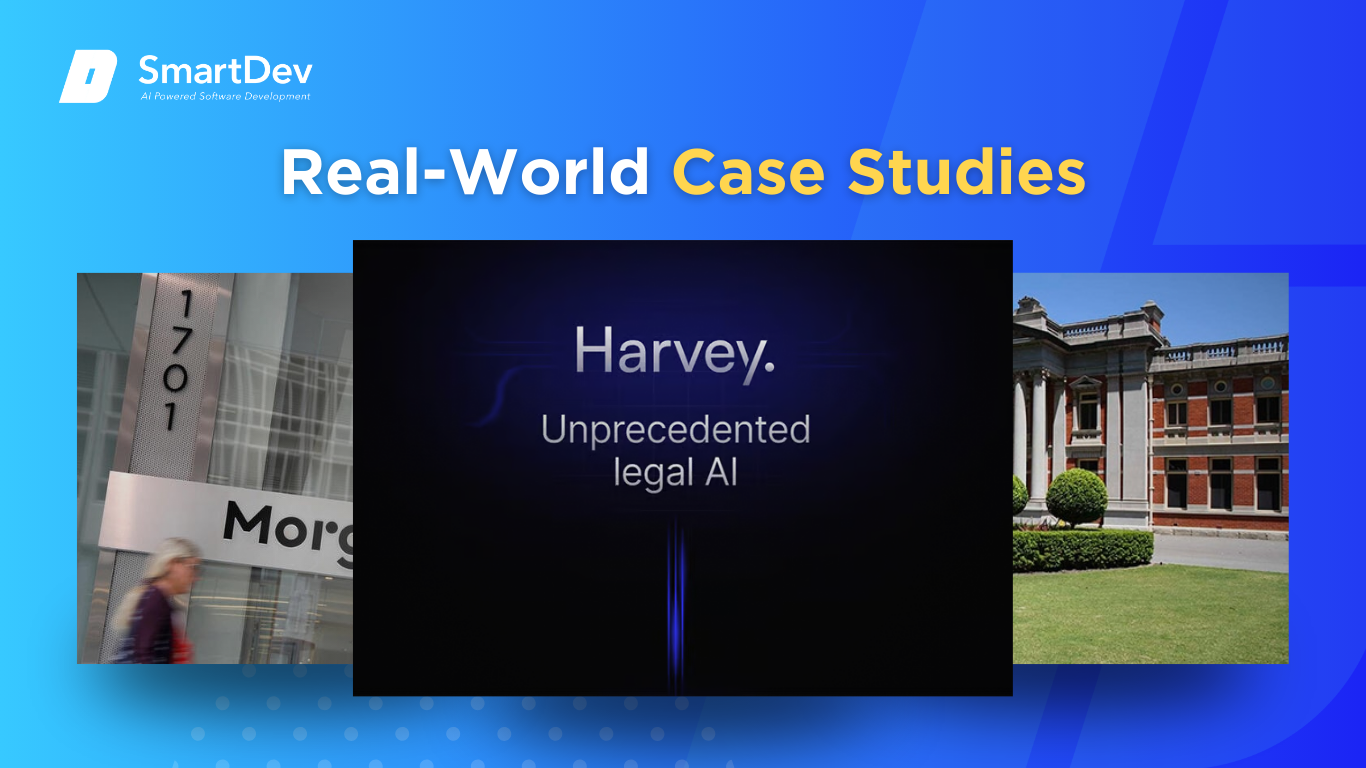
1. Ashurst: AI-Assisted Document Review in M&A
Ashurst, a global law firm, faced the recurring challenge of slow, manual document review during mergers and acquisitions. Their teams were spending substantial time reviewing non-disclosure agreements, supplier contracts, and compliance documents, creating bottlenecks in deal timelines. The firm needed a faster, more scalable solution that wouldn’t compromise legal accuracy.
To modernize the process, Ashurst adopted Harvey, an AI-powered legal assistant integrated with Microsoft Copilot. The platform uses NLP and machine learning to extract key clauses, highlight red flags, and summarize documents, speeding up due diligence reviews. This shift has led to significant reductions in time spent per transaction and improved the accuracy of initial reviews, with lawyers still overseeing the final decisions.
2. Morgan Lewis: AI for Research and Drafting Efficiency
Morgan Lewis, one of the world’s largest law firms, sought to improve efficiency in legal research and document drafting, two areas that traditionally consumed associate hours. As demand for faster turnaround and cost-efficiency grew, the firm explored AI as a way to modernize its knowledge workflows. The goal was to boost attorney productivity without compromising legal quality.
The firm partnered with Thomson Reuters to deploy generative AI tools that aid in drafting memos, summarizing case law, and preparing client correspondence. These tools are trained on verified legal databases and offer attorneys AI-generated drafts for quick iteration. Morgan Lewis reported faster document turnaround times and higher internal satisfaction, particularly among junior staff using the tools to accelerate learning and reduce routine work.
3. Western Australian Law Firm: Generative AI Risks in Immigration Law
In 2025, a small law firm in Western Australia encountered serious issues after an attorney submitted court documents containing fake AI-generated legal citations. These hallucinated case references, produced using tools like Claude AI and Microsoft Copilot, led to a referral to the legal regulator and a court-issued cost penalty of over AUD $8,000. The case underscored the need for rigorous human oversight in AI-assisted legal drafting.
Following the incident, the firm revised its AI usage policies, requiring all AI-generated content to be reviewed and verified by a qualified attorney before submission. The event triggered broader industry discussions around generative AI compliance and ethical risk management. It also highlighted the fine balance between leveraging efficiency and maintaining professional standards in AI adoption within law firms.
Innovative AI Solutions
AI-Driven Innovations Transforming Law Firms
Emerging Technologies in AI for Law Firms
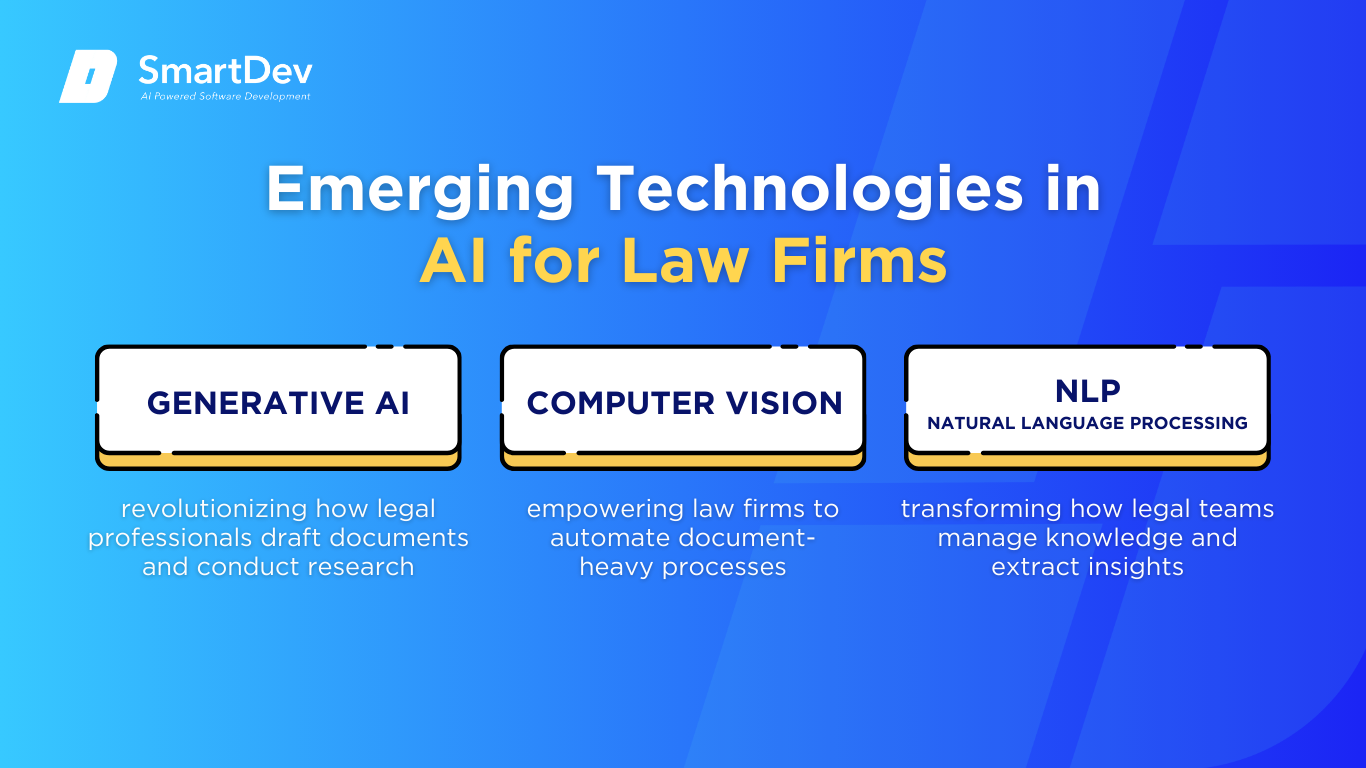
Generative AI, especially large language models like GPT-4, is revolutionizing how legal professionals draft documents and conduct research. These tools can instantly generate first drafts of contracts, summarize complex case files, and even suggest legal strategies based on precedent. This not only enhances productivity but also delivers faster, more responsive service to clients.
Computer vision is empowering law firms to automate document-heavy processes like e-discovery and contract review. Using OCR and machine learning, AI can extract key clauses from scanned PDFs, highlight red-flag terms, and compare thousands of contracts in minutes. By reducing reliance on manual review, firms save time, cut costs, and lower human error, creating leaner workflows with higher confidence in results.
NLP technologies are transforming how legal teams manage knowledge and extract insights from vast troves of unstructured data. AI can now read through years of case notes, court filings, and internal memos to identify relevant patterns, legal arguments, or judge tendencies. Tools powered by NLP also support internal search systems, allowing attorneys to retrieve answers or related cases in seconds instead of hours.
AI’s Role in Sustainability Efforts
AI is helping law firms move toward more sustainable, tech-enabled operations by reducing redundant tasks, minimizing paper dependency, and better forecasting resource usage. Predictive analytics tools assess historical case timelines and court schedules, allowing teams to optimize staffing levels and reduce unproductive overhead. Instead of wasting hours manually triaging low-priority matters, firms can use AI to route routine requests to automated systems, decreasing labor costs and environmental impact.
Data quality and resource management are also central to sustainability in legal operations. Law firms sit on troves of underutilized data like case archives, time logs, invoice records, when cleaned and organized, can drive smarter decision-making. AI tools can detect outdated or duplicate entries, improve record retention policies, and streamline knowledge sharing across departments. These backend improvements create a leaner, less wasteful environment.
How to Implement AI in Law Firms
A step-by-step guide for bringing AI into your legal practice, from readiness assessments and data preparation to choosing vendors, piloting tools, and team training.
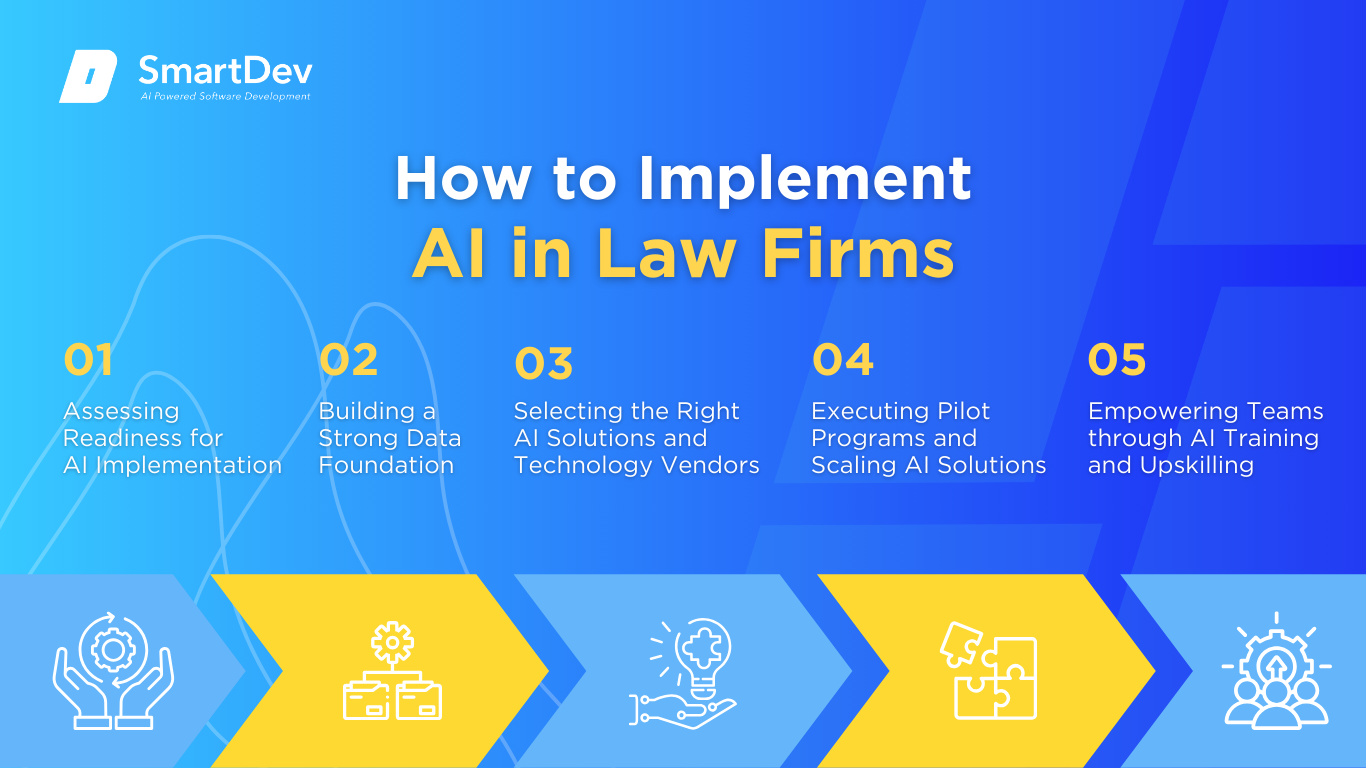
Step 1: Assessing Readiness for AI Adoption
Before investing in AI, law firm leaders need to identify where it can create the most value. Ideal entry points include automating legal research, managing contract workflows, reviewing invoices, and streamlining client intake. If your attorneys are bogged down in document review or billing inconsistencies, or if your firm struggles with knowledge management, these are clear opportunities where AI can create immediate impact.
Beyond identifying pain points, assessing your firm’s tech infrastructure and culture is equally vital. Are your systems cloud-ready? Can your teams adapt to tech-assisted workflows? And perhaps more critically, do your partners and associates trust the outputs of AI? Evaluating both operational readiness and mindset maturity sets the tone for AI to serve not just as a legal tech fad but as a firmwide accelerant for smarter, faster legal services.
Step 2: Building a Strong Data Foundation
AI in law is only as smart as the legal data it’s trained on. That’s why building a structured, centralized data framework is non-negotiable. This means organizing everything from case precedents and internal memos to time logs, billing records, and client interactions. Structured data enables models to find meaningful patterns—helping lawyers draft smarter, flag anomalies faster, and respond more accurately to client needs.
Data consistency is critical. Your records must be clean, deduplicated, and clearly labeled. Firms like Sidley Austin are actively investing in “AI councils” focused on data hygiene and taxonomy alignment. When done right, this foundational work fuels AI tools that can reliably assist with contract analysis, legal citation validation, and predictive case outcome modeling—without compromising accuracy or ethics.
Step 3: Choosing the Right Tools and Vendors
AI tools must solve real problems—not just add digital flair. Whether you’re exploring legal research copilots, contract review engines, or invoice auditors, prioritize solutions built specifically for legal workflows. Tools like Harvey, Casetext, or Lex Machina are designed with attorneys in mind, often including critical features like citation tracking and jurisdictional filters.
Vendors should also be evaluated for explainability, compliance, and security. Legal work demands traceability—so black-box models without transparency into how they reach conclusions can create risk. Look for partners with strong legal industry track records and the ability to integrate smoothly with practice management software, document management systems, and e-billing platforms. Responsible governance starts with responsible procurement.
Step 4: Pilot Testing and Scaling Up
Start small, fail safely, and iterate fast. Pilot your AI solution with a single team or practice group, like using a contract review AI for NDAs or a research assistant for litigation memos. The goal isn’t perfection out of the gate; it’s learning what works, what doesn’t, and how teams interact with the technology in real-world scenarios.
Once the pilot demonstrates clear benefits—like faster turnaround on briefs or fewer errors in billing, you can expand incrementally across offices, departments, or case types. This stepwise rollout ensures better change management and lets your teams build confidence at their own pace. Firms like DLA Piper use this phased approach, measuring each stage rigorously before scaling AI deployments across the organization.
Step 5: Training Teams for Successful Implementation
Even the most advanced AI tool is only as effective as the team using it. That’s why ongoing training is a cornerstone of successful AI adoption. Educate lawyers and support staff not just on how to use new tools, but how the models make decisions, where human review is still essential, and how to verify outputs to avoid ethical missteps, especially with generative AI.
Culture matters. Involve attorneys, paralegals, IT, and compliance in shared discussions about AI policy and risk. When teams see AI as a strategic assistant, augmenting their legal judgment rather than replacing it—they’re more likely to engage, adapt, and innovate. Forward-looking firms are building AI fluency as a core skill, turning legal technologists into champions of responsible, high-impact transformation.
Measuring the ROI of AI in Law Firms
Key Metrics to Track Success
Measuring ROI on AI investments in law firms starts with analyzing operational efficiency and cost reduction. One of the most immediate metrics is turnaround time on routine legal tasks. AI tools used for invoice review and contract analysis have reduced processing times from several minutes, or even hours, to mere seconds. In invoice auditing, for example, large language models (LLMs) achieved 92% accuracy and processed invoices 50x faster than humans, cutting per-invoice review costs from over $4 to just pennies.
Productivity gains translate into real financial impact. AI reduces the need for junior attorneys to comb through lengthy documents, freeing them to focus on strategic legal work. Time saved on legal research, document redlining, and due diligence directly increases billable hour potential. Firms also see fewer errors and compliance risks, which mitigates liability and improves client trust, adding indirect but critical value.
Case Studies Demonstrating ROI
DLA Piper offers a compelling case of measurable AI ROI. By piloting generative AI copilots for legal drafting and memo creation, they were able to A/B test AI-supported attorneys against traditional workflows. The result: increased drafting speed, faster response times to client inquiries, and more accurate citations, streamlining work that previously took hours into deliverables finished in minutes.
Irell & Manella took a different approach, building a custom AI platform called IP3 to analyze patent data and generate investment reports. Though still early-stage, this tool enables analysts to scan vast IP portfolios and produce structured insights in a fraction of the time, allowing attorneys to focus on client-facing strategy. This kind of augmentation is turning manual intellectual property analysis into a data-driven, scalable service offering.
Common Pitfalls and How to Avoid Them
One of the most common AI pitfalls in law firms is poor data hygiene. Inconsistent document formats, siloed case files, and outdated billing records can corrupt model outputs and undermine decision-making. Without clean, structured data, even the most advanced AI tools will struggle to deliver reliable results. Firms must invest early in data standardization and enforce strong data governance to avoid these issues.
Another major risk is blind trust in AI-generated content. Legal professionals have already faced fines and reputational damage for submitting fabricated citations from generative tools. These errors happen when AI is used without human review or transparency. To mitigate this, firms need clear usage policies, model explainability, and mandatory checks to ensure that AI supports legal expertise.
Future Trends of AI in Life Insurance
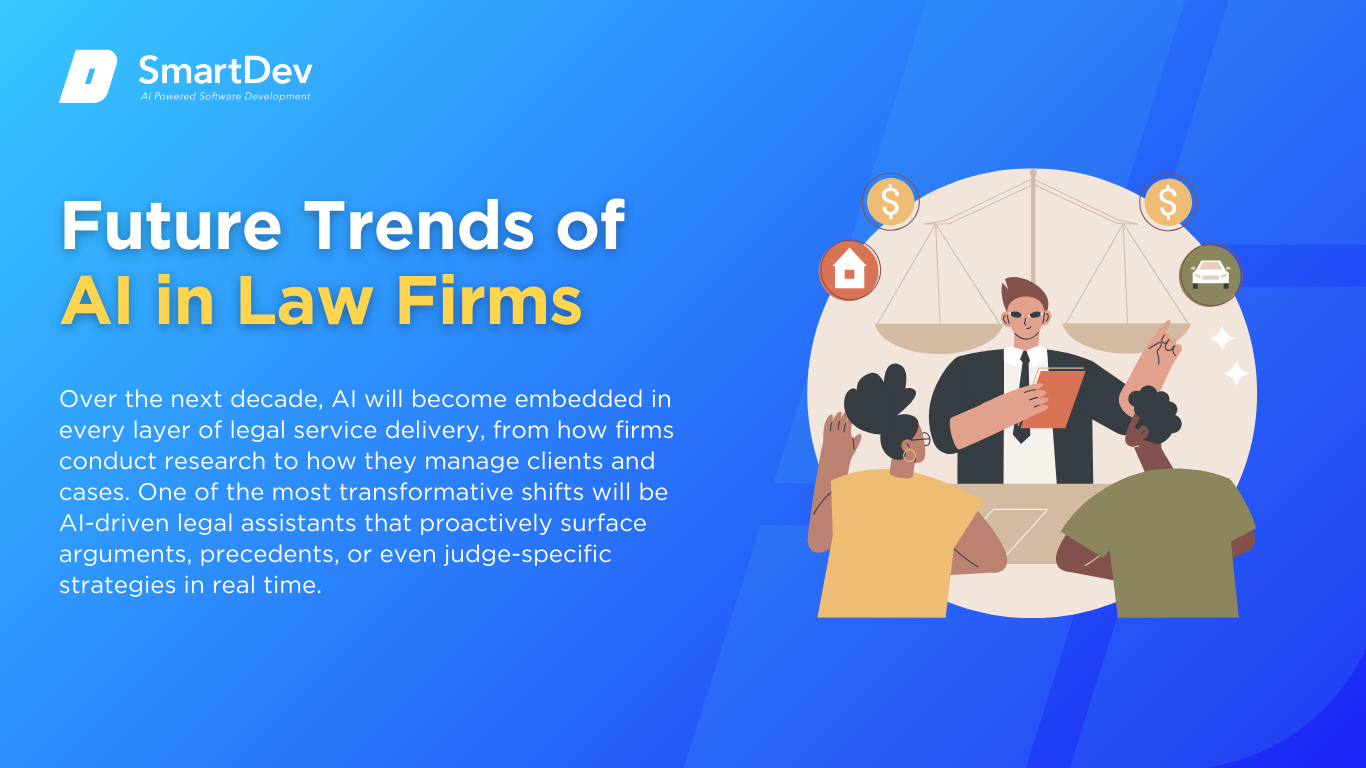
Predictions for the Next Decade
Over the next decade, AI will become embedded in every layer of legal service delivery, from how firms conduct research to how they manage clients and cases. One of the most transformative shifts will be AI-driven legal assistants that proactively surface arguments, precedents, or even judge-specific strategies in real time. These systems will anticipate legal needs and suggest next steps based on ongoing matter data and firm-wide learnings.
Generative AI will also redefine how legal documents are created. Attorneys will collaborate with LLMs to draft personalized contracts, filings, and advisory notes in minutes, fine-tuning tone and legal nuance on the fly. Natural language search will replace legacy databases, while computer vision may assist in parsing physical evidence, scanned exhibits, or courtroom footage. Combined, these tools will unlock a more agile, insight-rich legal workflow—and push firms toward virtual-first service models with smarter, faster client outcomes.
How Businesses Can Stay Ahead of the Curve
Staying ahead in this AI-driven legal future requires more than just adopting tools—it means rethinking how your firm operates. This starts with investing in integrated, AI-ready systems that break down silos between litigation, compliance, billing, and client services. Firms that unify their data across departments will have a major head start in building powerful, responsive legal intelligence engines.
Equally important is fostering a culture of experimentation. Create cross-functional AI teams that bring together legal experts, technologists, and knowledge managers to pilot new use cases, whether it’s building predictive litigation models, automating conflict checks, or testing real-time brief drafting. Law firms that treat AI as a continuous capability will lead the market in agility, accuracy, and client value. The future is about building the mindset and infrastructure to evolve with it.
Conclusion
Key Takeaways
AI is rapidly transforming the legal landscape, streamlining everything from legal research and contract analysis to billing review and client engagement. With technologies like generative AI, NLP, and computer vision, law firms are cutting down on repetitive tasks, boosting accuracy, and delivering faster, more personalized services to clients.
Beyond efficiency, AI is enabling law firms to scale more sustainably. By organizing unstructured data, automating low-value tasks, and enhancing decision-making with predictive insights, firms are seeing measurable ROI in speed, cost reduction, and client satisfaction. Examples from DLA Piper, Irell & Manella, and McDermott Will & Emery show that AI isn’t just hype; it’s creating real, strategic value today.
Moving Forward: A Strategic Approach to AI in Law Firms
AI is no longer a fringe experiment for law firms; it’s a strategic imperative. To harness its full potential, firms must invest in data infrastructure, promote collaboration across legal and tech teams, and train staff to confidently integrate AI into their workflows. Embedding AI into everything from document management to case analysis prepares firms to compete and lead in a rapidly changing legal market.
At SmartDev, we help law firms implement ethical, intelligent AI solutions, whether it’s generative legal drafting, automated billing reviews, or internal research copilots. Whether you’re exploring AI for the first time or scaling enterprise adoption, we’re here to guide you every step of the way.
—
References:
- ABA Tech Survey Finds Growing Adoption of AI in Legal Practice | LawNext
- ABA Technology Survey Shows Lawyers as Cautious Adopters of Generative AI | Lawyers Mutual NC
- Generative AI for Legal Professionals: Top Use Cases | Thomson Reuters
- GenAI Report Executive Summary for Legal Professionals | Thomson Reuters
- Ashurst Launches Global Harvey Partnership | Ashurst
- How AI Is Transforming the Legal Profession | Thomson Reuters
- Ashurst’s AI Innovation with Harvey | Harvey AI
- Morgan Lewis and Thomson Reuters Partner to Develop AI Solutions for Law Firms | Morgan Lewis







